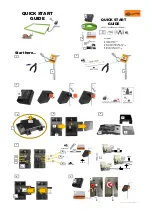
!
2
network. This process is called
Inclusion
. Devices can also
leave a network. This process is called
Exclusion
. The
primary controller of the Z-Wave network initiates both
processes. This controller will be turned into exclusion
respective inclusion mode. Please refer to your primary
controllers manual on how to turn your controller into
inclusion or exclusion mode. Only if the primary controller is
in inclusion or exclusion mode, this device can join or leave
the network. Leaving the network - i.e. being excluded -
sets the device back to factory default. If the device already
belongs to a network, follow the exclusion process before
including it in your network. Otherwise inclusion of this
device will fail.
When in factory default mode a
1 sec. click
on any button will trigger the device for 5
sec to accept inclusions
(red and green
LEDs blink slowly).
Button 1 in management mode
confirms inclusion or exclusion.
Operating the device
Depending on the button mode and command set
configured the key fob can be used in different ways.
Button Group modes:
Control with two groups of two buttons:
(default) One
group (No. 1) of devices is controlled by button 1 and 3, the
other group (No. 2) is controlled by button 2 and 4. Clicking
the larger button turns the loads ’ON’, clicking the smaller
button turns the loads ‘OFF’. If double clicks are enabled in
configuration parameters #1 or #2, groups No. 3 and No. 4
are controlled by short double click of the buttons.
Dimming commands are sent by holding down the buttons
(Dim UP using Buttons 1 and 2, Dim Down using Buttons 3
and 4) respective Click + Hold in case the double click
option is enabled.
Control with single buttons:
A group of devices is
controlled by a single button: single click turns ‘ON’; double
click turns ‘OFF’ devices in the group. In case dimmers are
controlled, holding down the button will dim up, click and
hold down will dim down the load. The group number
corresponds to the button label.
Control Commands Sent Out:
The configuration parameters #11
…
#14 specify what
commands are sent when the buttons are operated.
Direct Control of associated devices:
(This is the default
mode No. 1). Devices in association groups are controlled
using Basic ‘ON’ and ‘OFF’ commands and Dim Start/Stop
commands. This mode implements the communication
pattern
7
. The parameter value No. 2 disables the use of
Dim commands.
Control of Devices in proximity:
Basic ‘ON’, ‘OFF’ and
Dim Start/Stop commands are sent to the device nearest to
the Fob. (50...100 cm) Attention: In case there is more than
one Z-Wave device nearby all these devices may be
switched. For this reason the proximity function should be
handled with care. This mode implements the
communication pattern
7
.
Control of all devices in Z-Wave network:
The special
commands ‘ALL ON’ resp. ‘ALL OFF’ are sent as broadcast
to all devices in direct wireless range. The devices act
according to their individual settings for ‘Switch ALL’
commands. This mode implements the communication
pattern
7
.
Simple Scene Activation:
Devices in an association group
are controlled by individual commands defined by Z-Wave
command class ‘Scene Controller Configuration’. One
scene number can be configured per association group. On
default, the scene number equals the association group
number as shown in the figure below. This mode
implements communication patterns
6
and
7
. This mode is
typically used to activate scenes in IP gateways but can
also be used to activate predefined scenes in other scene-
capable devices.
Enhanced Scene Activation
: In this mode every button
action can issue a scene activation command with a
dedicated number. The scene number is a combination of
the group number and the action performed on the button
and has always two digits. The group number defines the
upper digit of the scene number, the action the lower digit.
The following actions are possible:






















